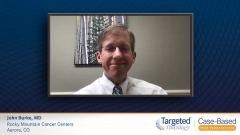
Frontline Treatment Options for R/R DLBCL
John Burke, MD, discusses frontline treatment options for relapsed/refractory diffuse large B-cell lymphoma (R/R DLBCL).
John Burke, MD: What frontline treatment options are available for patients? Well, of course, the standard of care, as all of you know, for the management of diffuse large B-cell lymphoma [DLBCL] is R-CHOP [rituximab, cyclophosphamide, H – doxorubicin (hydroxydaunomycin) vincristine )oncovin), prednisone] chemotherapy. The large majority of our patients get that treatment. Certainly, there are exceptions. For example, in the cases of our older patients, some of them may have impaired performance status or comorbidities that prevents the administration of full-dose R-CHOP. Those patients may be treated with reduced doses, or the so-called R-mini-CHOP regimen [rituximab and reduced-dose CHOP]. Patients who have severe cardiac impairments may not be able to receive any doxorubicin at all. For those patients, an alternate regimen might be considered, such as a substitution of etoposide for the doxorubicin. There is not really a single standard of care for patients who are not eligible for R-CHOP, and we know from many series that those patients tend to receive a mixture of different regimens. As I mentioned before, patients with double-hit lymphoma and triple-hit lymphoma fare poorly with R-CHOP and they have high rates of relapse. Phase 2 studies have demonstrated improved outcomes using more intensive chemotherapy regimens in those patients.
Although no randomized Phase 3 trial has proven a benefit to such intensive regimens, most institutions and experts now recommend more aggressive regimens for those patients with double-hit or triple-hit lymphoma. Examples of such regimens include the dose-adjusted EPOCH-R (etoposide, prednisone, vincristine, cyclophosphamide, doxorubicin, and rituximab) regimen or R-hyper-CVAD [rituximab and cyclophosphamide, vincristine, adriamycin [doxorubicin], and dexamethasone] at some institutions. In clinical practice, one question that comes up is, should we wait on the FISH [fluorescence in situ hybridization] results? I am in a community practice, and the turnaround time for FISH in my hospitals is a couple of weeks sometimes; our pathologists do not do FISH locally. We send it out to a central lab, and it is not uncommon for it to take about 2 weeks to come back. Typically, the time between the diagnosis of lymphoma and the time I get the FISH back is more than 2 weeks. That is, we see the patient, and we get a staging PET scan and a CT scan. We may need a bone marrow biopsy, and then we get the drugs authorized. We teach our patients about treatment. That whole process typically takes me approximately 2 weeks.
By the time I initiate the therapy, I usually have the results of FISH test back. Occasionally, though, I need to move things more quickly and treat patients in the hospital. For those patients, I will sometimes start chemotherapy before the FISH result is back. If it happens that I have started someone on R-CHOP and the result comes back that they have a double-hit or a triple-hit lymphoma and I want to use a more aggressive regimen, that is fine. I just switch them to the more aggressive regimen for cycle 2.
What typically is the response rate and duration of response after R-CHOP? Most studies show that the overall response rate for R-CHOP chemotherapy for patients with DLBCLs is between 75% and 90% with complete remissions achieved in between 55% and 70% of patients. 3-year progression-free survival is generally reported at about 65% to 70%. For all-comers, we generally think that we cure diffuse large B-cell lymphoma with R-CHOP in about 60% of patients.
Transcript edited for clarity.
Case: A 76-Year-Old Man with R/R DLBCL
Initial presentation
- A 76-year-old man presented with fatigue, loss of appetite
- PMH: atrial fibrillation, hypertension, medically controlled
- PE: palpable 5 cm right inguinal mass; bilateral axillary lymphadenopathy; splenomegaly
- ECOG PS 2
Clinical Workup
- Labs: Hb 9.9 g/dL; all others WNL
- Hepatitis B, C and HIV negative
- Excisional biopsy of the lymph node confirmed DLBCL, GCB subtype
- IHC positive for CD20
- FISH panel: t(14;18) with a BCL2 rearrangement
- Flow cytometry: CD19-postitive
- Whole body PET/CT scan showed diffuse lymphadenopathy , splenomegaly
- Ann Arbor stage III DLBCL
- IPI score intermediate-risk
Treatment
- Treated with R-CHOP x 6 cycles
- First post-treatment PET/CT scan was unremarkable; CR
- 1 year later he presents with recurrent axillary lymphadenopathy
- Repeat biopsy confirms relapse of DLBCL, GCB subtype
- He was ineligible for high-dose chemotherapy and ASCT
- Initiated tafasitamab + lenalidomide







































